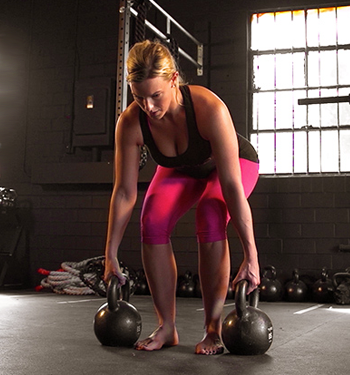Though you may often hear about everything you shouldn’t be doing, there are many options for safe and comfortable exercise during pregnancy.
Rather than confusing you with yet another list of specific exercises you should or should not do while pregnant, I want to help you feel more confident in understanding what your body is trying to tell you.
Certain physical sensations are important to key into so that you can safely enjoy staying active throughout your pregnancy.
As you continue reading, keep in mind that I’m not suggesting that you necessarily stop any specific exercise altogether, forever! Instead, if you are experiencing any of the signs or symptoms discussed below seek some guidance from a pelvic floor physiotherapist or a fitness trainer who is educated in prenatal exercise.
Also keep in mind that for every scenario below you may need to make some minor tweaks to your form or alignment to make an exercise more comfortable or safer for your body in pregnancy.
Exercises That Cause Pain Or Discomfort
Feeling pain during or after an exercise is a sign that perhaps it isn’t suiting your body. The most common areas for pain in pregnancy tend to be:
- Front of the pelvis, also known as symphysis pubic dysfunction (SPD)
- Back of the pelvis, also known as sacroiliac (SI) joint pain
- General low back pain
- Knees
For example, you might be feeling stiffness or pain in your low back the day after a workout that included kettlebell deadlifts. This doesn’t necessarily mean that you have to eliminate deadlifts entirely in your program for the remainder of your pregnancy. However, don’t ignore the symptoms.
Pain and discomfort are good indicators that the body needs some additional support, which can come from more optimal body alignment, more focused breathing, or reducing the load in the exercise.
In the deadlift example from above, you could try two different adjustments to alleviate the lingering low back discomfort:
- Start your exhale breath before you begin pulling the kettlebell off the floor. This is what I cue as “exhaling on exertion.” Start your exhale breath and continue exhaling as you finish standing up at the top of the deadlift.
- At the top of the deadlift make sure that your ribcage stays down, or directly over your hips. Watch that you’re not flaring your chest up towards the ceiling.
Both of these cues can help to support your pelvis and low back by creating more stability in your trunk.
Exercises That Cause Leaking
Leaking urine during exercise is not a normal function of the body.
This is a somewhat common experience from women during pregnancy (and afterward, too), but rest assured that this does not need to be your new normal in or outside of the gym.
Leaking during exercise could show up at any movement, but most commonly during:
- Running, jumping, or skipping
- Heavier deadlifts or squats
- Chin-ups or lat pull downs
- High rep abdominal work such as double leg raises, or crunches
As with some instances of pain or discomfort, leaking doesn’t automatically mean that a particular exercise is ruled out for you. It is simply another clear warning sign from your body, asking you to tune in.
Let’s look at running during pregnancy as an example. You might continue running in your pregnancy because you truly love that form of exercise and want to keep doing it as long as safely possible. You notice that you are occasionally leaking while running, even though your pace is slower and your distance is shorter than it was pre-pregnancy.
The first thing I recommend here is looking at your body alignment in your running technique. Are you running completely upright? If so, try shifting your body forward a bit more so you are at a slightly inclined angle. This can allow your core and pelvic floor system a greater opportunity to respond to the pressures on your pelvic floor during high-impact exercise like running.
Exercises That Make You Feel Like Your Belly Bulges Out
As you get into the mid or later stages of pregnancy, you might be feeling as though your belly is bulging out all the time! However, what I’m talking about is a different sensation than simply “being pregnant.” What I mean here is that you should avoid exercises that make you feel a constant outward pressure along your abdominal wall.
 This is not the same as muscle tension, or feeling your abs are working (that’s good!). Rather it is a sensation that makes you want to hold your belly up and in to relieve the pressure because it’s truly uncomfortable. This might feel like straining in your abdominal muscles or something that feels like a direct pulling around your belly button that increases with specific exercises. You might experience this sensation while in a front plank, or while doing push-ups or a twisting movement.
This is not the same as muscle tension, or feeling your abs are working (that’s good!). Rather it is a sensation that makes you want to hold your belly up and in to relieve the pressure because it’s truly uncomfortable. This might feel like straining in your abdominal muscles or something that feels like a direct pulling around your belly button that increases with specific exercises. You might experience this sensation while in a front plank, or while doing push-ups or a twisting movement.
To help reduce this bulging, pulling, or straining sensation, you may need to elevate your planks or push-ups to an incline with your hands on a bench, for example.
By the way, this “belly bulging” sensation could happen during any stage of pregnancy, whether or not you even look pregnant! Always listen to your body and learn to recognize this feeling.
Exercises That Make You Feel Bulging In Your Perineum
Of all the sensations mentioned in this article, pay particularly keen attention to this one as it could directly impact your long-term pelvic health.
 Your perineum is the tissue that connects the vagina to the anus. This is an integral structure that helps to make up your pelvic floor support. If you are feeling downward pressure or bulging onto your perineum, this is a sign that the pelvic floor may not be coordinating optimally with the amount of pressure it’s working against.
Your perineum is the tissue that connects the vagina to the anus. This is an integral structure that helps to make up your pelvic floor support. If you are feeling downward pressure or bulging onto your perineum, this is a sign that the pelvic floor may not be coordinating optimally with the amount of pressure it’s working against.
A common example where this can occur is in a squatting exercise, where you might be feeling a bulging sensation on your perineum at the bottom of your squat. If you experience this, take a closer look at your breathing patterns throughout your reps and, most importantly, make sure that you’re not holding your breath.
Inhale on the way down into your squat, then, just before you reach the bottom of your squat, start your exhale breath and continue it as you reach a full standing position at the top of your squat.
It’s likely that this simple focus on breathing could help you to feel more supported in your pelvic floor and reduce any bulging sensation in your perineum.
Exercises That Make You Question Whether or Not You’re Letting Your Ego Take Over
I frequently remind my clients to ask themselves this question: “Could I, or Should I?”
Remember there is no “pregnancy exercise badge of honor.” Yes, it’s fantastic to exercise in pregnancy and to physically challenge yourself appropriately. However, this doesn’t mean that you must continue exercising intensely throughout your entire pregnancy.
You might be able to do something, but perhaps that form of exercise or the amount of weight you’re lifting is not optimal for your pregnant or soon-to-be postpartum body.
The options for exercising during pregnancy are not simply walking or running marathon distances. Likewise, you’re not stuck choosing between doing only bodyweight training or lifting extremely heavy weights. There is a vast grey area for you to explore.
It is OK to slow down. It is OK to keep working out.
Tune in to what your body is telling you, and if you’re getting any hints that your body needs you to back off, do so.
If you’re not feeling any of the sensations mentioned above, keep going.
Your body is performing an incredible feat in pregnancy! Keep the focus of your exercise routine on helping your body feel comfortable and supported, right now and for the long term.
Note from GGS:
Smart strength training is an integral piece of the healthy pregnancy equation. Unfortunately there are still a ton of myths out there about strength training during pregnancy—but we can help!

Learn what are the 5 biggest myths of strength training in pregnancy! In this FREE report, we bust the five biggest myths and give you the TRUTH so you can have a strong, happy, and safe pregnancy.
(Make sure you read all the way through because #4 is super important!)
Click to grab our FREE Pregnancy Strength Training Myths Report
The post 5 Types of Exercise To Avoid In Pregnancy appeared first on Girls Gone Strong.






